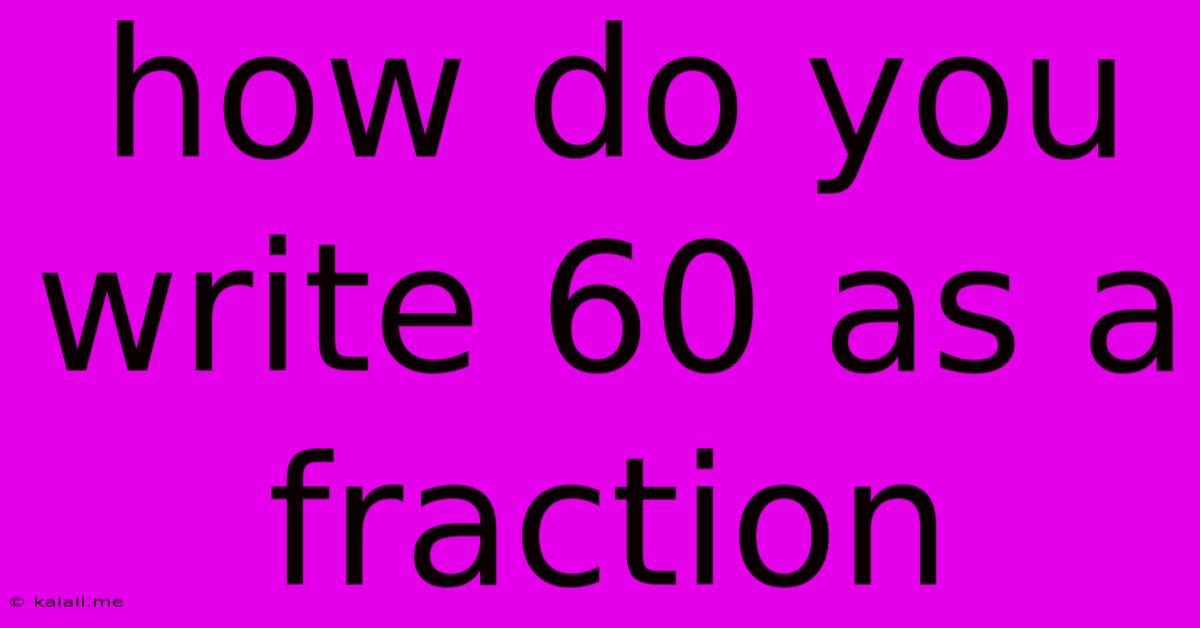How Do You Write 60 As A Fraction
Kalali
May 09, 2025 · 3 min read

Table of Contents
How Do You Write 60 as a Fraction? A Comprehensive Guide
This seemingly simple question, "How do you write 60 as a fraction?", opens the door to understanding fundamental concepts in mathematics, specifically fractions and their representation. While the answer might seem obvious at first glance, delving deeper reveals various ways to express 60 as a fraction, each with its own implications and uses. This article will explore these different representations and clarify the underlying principles.
Understanding Fractions: A Quick Refresher
Before we dive into expressing 60 as a fraction, let's quickly review the basic components of a fraction. A fraction represents a part of a whole. It consists of two numbers:
- Numerator: The top number, indicating the number of parts you have.
- Denominator: The bottom number, indicating the total number of equal parts the whole is divided into.
Expressing 60 as a Fraction: The Simplest Form
The most straightforward way to write 60 as a fraction is to place it over 1: 60/1. This represents 60 out of 1 whole unit. This is the simplest improper fraction representation. An improper fraction is one where the numerator is greater than or equal to the denominator.
Other Fraction Representations of 60
While 60/1 is the simplest and most common representation, 60 can be expressed as numerous other fractions. This involves finding equivalent fractions. Equivalent fractions represent the same value, even though they look different. For instance:
- 120/2: This represents 120 parts out of a whole divided into 2 equal parts. Dividing both the numerator and denominator by 60 simplifies it back to 60/1.
- 180/3: Similar to the above, this simplifies to 60/1.
- 300/5: And so on. You can create infinitely many equivalent fractions by multiplying both the numerator and denominator by the same number.
Simplifying Fractions: Finding the Lowest Terms
The concept of "simplifying" a fraction means reducing it to its lowest terms. This involves finding the greatest common divisor (GCD) of the numerator and denominator and dividing both by it. For example, if we had the fraction 120/2, the GCD of 120 and 2 is 2. Dividing both by 2 results in 60/1. In the case of 60/1, it's already in its simplest form because the GCD of 60 and 1 is 1.
Practical Applications and Context
Understanding how to express 60 as a fraction, and fractions in general, is crucial in various applications, including:
- Measurement: Dividing objects or quantities into parts.
- Cooking: Following recipes with fractional measurements.
- Construction: Precise measurements in building and engineering.
- Data Analysis: Representing proportions and ratios.
Conclusion:
In conclusion, while the most straightforward way to represent 60 as a fraction is 60/1, it's important to understand the concept of equivalent fractions and simplification. This fundamental understanding of fraction manipulation is vital for tackling more complex mathematical problems and real-world applications. Remember that the choice of fraction representation often depends on the specific context and desired level of detail.
Latest Posts
Latest Posts
-
Why Did The Kangaroo See A Psychiatrist
Jul 06, 2025
-
How Long Would It Take To Walk To China
Jul 06, 2025
-
Step Up To The Streets Final Dance
Jul 06, 2025
-
How Many Grams Is Half An Oz
Jul 06, 2025
-
How Much Is 10 Quarters In Dollars
Jul 06, 2025
Related Post
Thank you for visiting our website which covers about How Do You Write 60 As A Fraction . We hope the information provided has been useful to you. Feel free to contact us if you have any questions or need further assistance. See you next time and don't miss to bookmark.